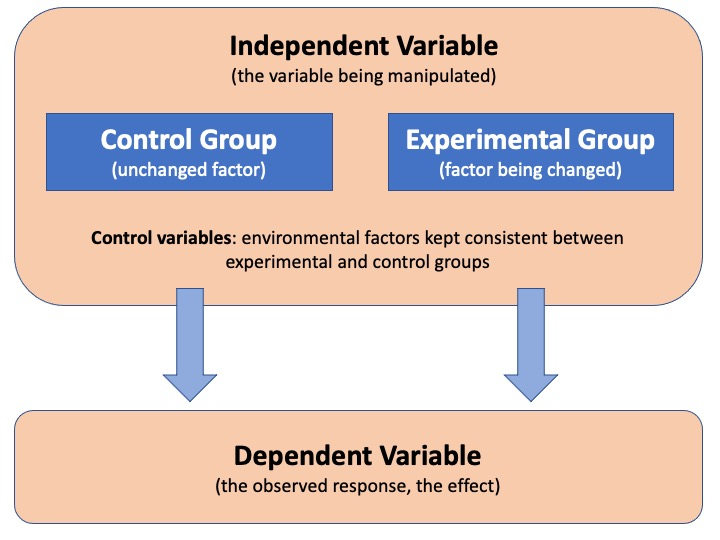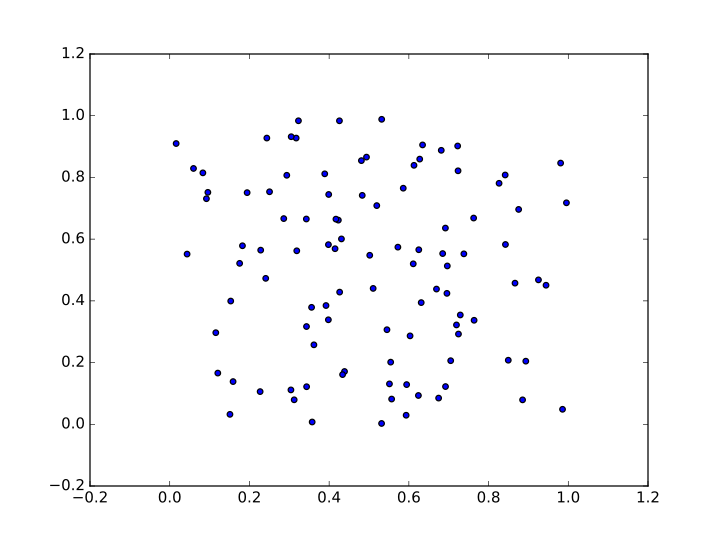OCR Specification focus:
‘Identify independent, dependent and control variables, and specify how key variables will be controlled where appropriate.’
Carefully identifying, defining and controlling variables is essential for reliable experimental design, ensuring that data collected can be interpreted with confidence and linked to the biological question.
Identifying Variables in Biological Experiments
A clear experimental plan must demonstrate how different variables relate to the aim, so that results can be used to test a biological hypothesis. OCR requires students to recognise and categorise the variables that influence an investigation.
When planning any investigation, three main types of variables must be stated: the independent, dependent, and control variables. These determine how data should be collected and how trends and relationships can be interpreted in the analysis stage.

Diagram showing how the independent variable is manipulated, the dependent variable is measured, and control variables are held constant to ensure valid comparisons between experimental and control groups. Source.
Independent variable: the factor that is deliberately changed by the investigator to observe its effect.
A well-designed experiment must have only one independent variable where possible. This allows a direct link between cause and effect.
Dependent variable: the factor that is measured to assess the effect of the independent variable.
The dependent variable must be quantitative or qualitative in a measurable form, ensuring that data can be recorded objectively using appropriate units.
After identifying the main variables, all other factors that could influence the dependent variable must be considered. These are the control variables, which must be kept constant to ensure a fair test.
Control variables: factors that must be kept constant to prevent them influencing the dependent variable.
Characteristics of the Three Variable Types
Students should remember the following when planning:
Independent variable: one per investigation, changed in regular intervals where appropriate
Dependent variable: must be measurable, recorded systematically
Control variables: numerous and experiment-specific, controlled using detailed procedures

Scatter plot illustrating the convention that independent variables are placed on the x-axis and dependent variables on the y-axis, supporting interpretation of relationships in experimental data. Note: this image includes general graphing conventions that extend beyond this subtopic but remain useful context for variable relationships. Source.
Controlling Variables to Ensure Validity
The main purpose of controlling variables is to ensure validity, meaning that the investigation actually measures the effect of the independent variable on the dependent variable. If control variables are not managed, they can act as confounding factors, reducing confidence in conclusions.
To ensure effective control, students must:
Recognise which external factors could influence the results
Describe how each factor will be controlled
Use consistent and replicable techniques throughout
Common Methods for Controlling Variables
Control can be achieved in various ways, depending on the biological context:
Environmental control: keeping temperature, pH, light intensity, or humidity constant using thermostats, buffers, or fixed-distance light sources
Equipment control: using the same apparatus model, same volume of solution, or calibrated instruments
Biological control: using organisms of the same species, age, and physiological condition
Procedural control: keeping time intervals, reagent concentrations, and mixing techniques identical
Where a variable cannot be controlled, it should be monitored and recorded so its potential effect can be evaluated later.
Writing Control Measures in Methodology
OCR expects more than naming control variables; students must state how each will be controlled. High-quality method writing should include:
The variable to be controlled
The method of control
The equipment used (if relevant)
The measurement units or conditions being standardised
For example, instead of writing “temperature controlled,” a stronger approach is “maintain temperature at 25 °C using a thermostatically controlled water bath.” This creates clarity, reproducibility, and scientific rigour.
Linking Variables to Fair Testing, Reliability and Reproducibility
Valid control of variables contributes to a fair test, where only the independent variable affects the outcome. Good control also improves:
Reliability, by reducing variability in repeated trials
Reproducibility, by allowing other investigators to repeat the method and obtain similar results
Multiple repeats and consistent control conditions reduce the influence of random error and strengthen confidence in emerging patterns.
Variables in Biological Contexts
Different branches of biology require different control strategies, but the principles remain constant. Whether investigating enzyme activity, plant growth, or animal behaviour, controlling variables ensures that observed outcomes relate only to the chosen independent variable.
Students must show clear scientific reasoning when justifying variable choices, directly linking controls to the experimental aim. This meets OCR expectations for rigorous planning and strengthens the scientific value of collected data.
FAQ
A control variable is a factor kept constant to prevent it affecting the dependent variable. Multiple control variables may exist in one experiment.
A control group, in contrast, is a whole experimental setup used for comparison. It does not receive the independent variable or treatment. This helps determine whether the independent variable is truly responsible for any observed change.
Identify all factors that could influence the dependent variable, then prioritise those most likely to cause measurable change.
Focus on variables that:
• directly affect the biological process being tested
• are known from prior knowledge or pilot studies to influence the results
• can be controlled using realistic equipment, time, and conditions
This is acceptable when the variable cannot be controlled practically or ethically. In such cases, the variable should be monitored and recorded.
If its influence is known, its potential impact can be discussed in the evaluation. This approach is often used in fieldwork or studies involving living organisms with natural variation.
A confounding variable is a factor that has not been controlled and influences the dependent variable, making the results less valid.
A control variable, by contrast, is recognised and actively kept constant. Confounding variables weaken conclusions by introducing uncertainty about the true cause of the results.
Pilot tests help reveal practical issues with variable control before the main data collection begins.
They can identify:
• which control variables are difficult to maintain
• how to refine equipment choices or timings
• unexpected sources of variation
This leads to clearer control procedures and more reliable final data.
Practice Questions
Question 1 (2 marks)
A student investigates the effect of light intensity on the rate of photosynthesis in pondweed. Identify the independent variable and the dependent variable in this investigation.
Question 1 (2 marks)
• Independent variable: light intensity (1 mark)
• Dependent variable: rate of photosynthesis (1 mark)
Question 2 (5 marks)
A student plans an investigation to determine how pH affects the activity of an enzyme. Describe how the student should identify and control the variables in this investigation to ensure valid results.
Question 2 (5 marks)
Award one mark for each valid point, up to five marks:
• Independent variable is pH, which should be changed systematically (1 mark)
• Dependent variable is enzyme activity, measured quantitatively (e.g., volume of product formed or time taken) (1 mark)
• Control variables identified, such as temperature, enzyme concentration, substrate concentration, and time (1 mark)
• Description of how control variables are maintained, e.g., thermostatically controlled water bath, same enzyme and substrate volumes, constant timing (1 mark)
• Validity ensured by keeping all control variables constant so only pH affects the dependent variable (1 mark)

